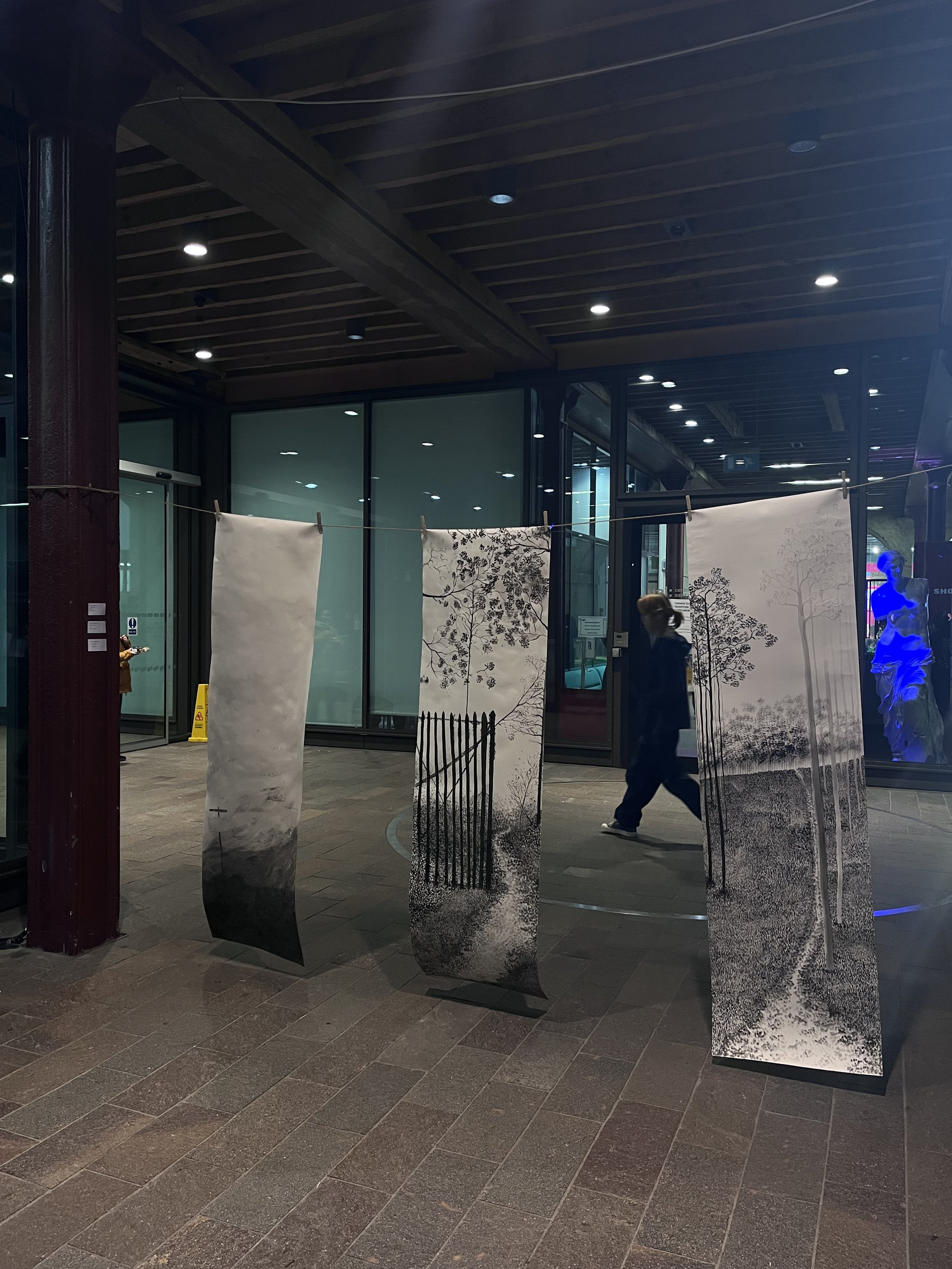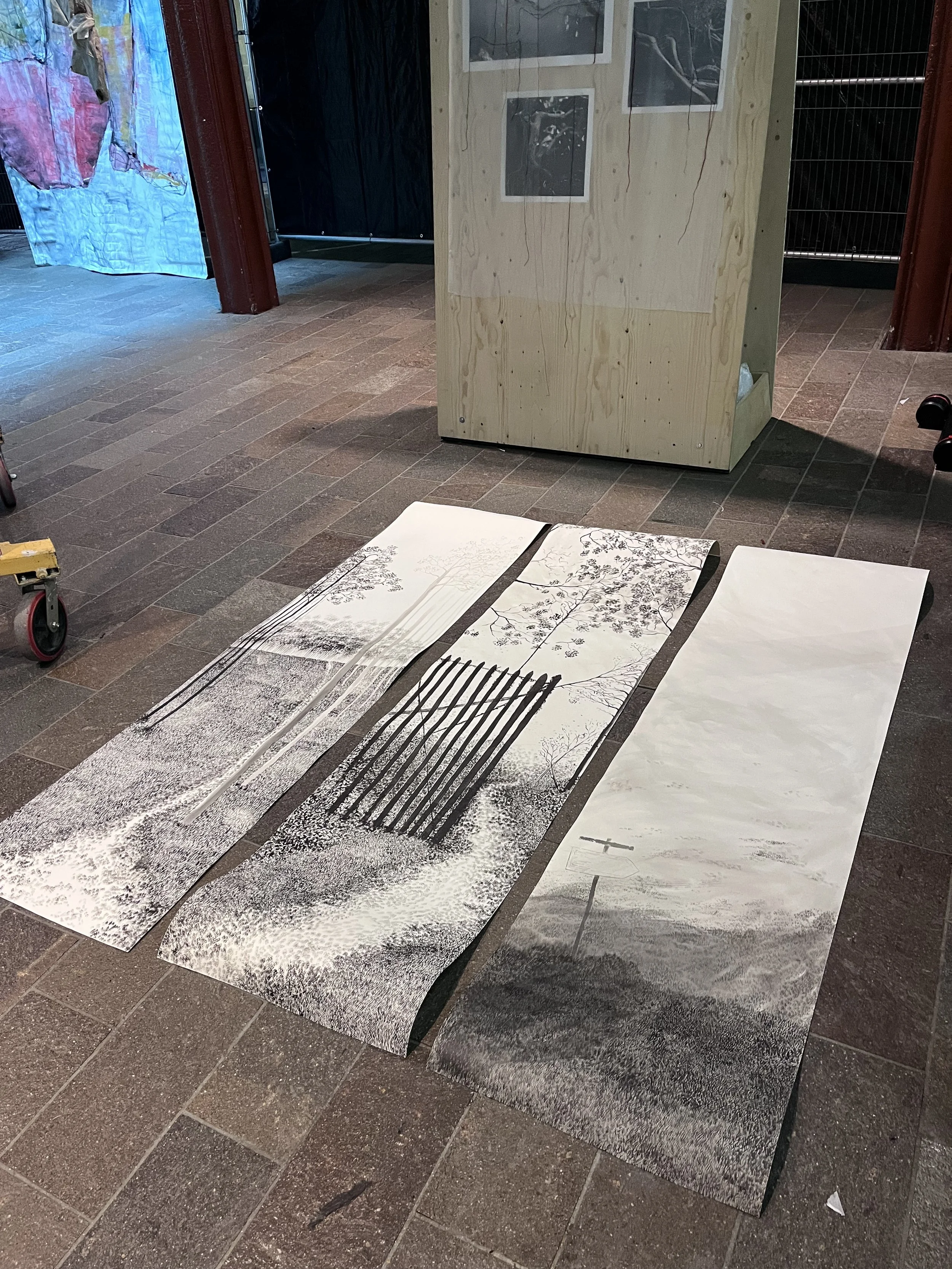Perhaps We Should Reconsider.
Reflections on The INterim Show.
March 2025 marked a big moment for me: my first time seeing my work in an exhibition, as part of the Central Saint Martins Interim Show Perhaps we should reconsider. Bringing together over 120 first-year MA Fine Art students from across the college, including those of us on the MA Fine Art: Digital course, the exhibition was a rich, expansive and somewhat surreal experience.
For this show, I exhibited three ink paintings titled Folm, Cache, and Understory v.2. Each of them measured roughly two metres in height and half a metre in width, painted in black ink on lining paper. The ink was watered down to create various depths and transparencies, allowing me to play with subtle layering and tone - something I’ve been increasingly drawn to in my practice. All three pieces were based on photographs I’d taken, each one rooted in a place that had left an emotional imprint on me.
Folm was based on a hike I took in the Pentland Hills on a day when the fog was so thick you could only see about six feet in front of you. It felt like being completely enveloped in a cloud - everything was muffled, quiet, soft. Despite being just outside the city, it felt like a completely separate world, detached from the constant background noise of urban life. That walk stayed with me. It was calming in a way that felt profound, and I tried to channel that sensation of suspended time and space into the painting.
Cache came from a photo I took of an old railway gate beside some allotments in the heart of the city - now a kind of unofficial shortcut that locals use to walk their dogs or pass through. I was interested in how these overlooked, repurposed paths exist quietly in the middle of cities. They offer a different kind of escape - hidden yet well-trodden, blending utility and secrecy. It felt like a good metaphor for those spaces we all have in our lives: the places we retreat to that aren't designed for retreat.
Understory v.2 was a continuation of a piece I had painted earlier in the year. The original was 1.5 metres in height, but for this version, I pushed the scale slightly further to 2 metres. Though I think I still prefer the first version when viewed on its own, this larger iteration felt necessary for the context of the installation. The two versions have distinct qualities. The second version demanded a different kind of attention - it created more of a physical presence in the space, which helped anchor the overall display.
For the installation itself, I wanted to introduce a visual and conceptual tension with the industrial feel of the space. My intention was to soften the urban harshness and reintroduce a sense of the natural - something quieter, more intimate. I chose to hang the pieces using hemp twine and wooden clothes pegs. This wasn’t just a practical solution; it was deliberate. I was drawing inspiration from traditional drying greens behind tenement flats - those humble, communal patches where laundry would be hung between buildings. There's something nostalgic about that visual, something rooted in memory and domestic rhythm.
Using twine also tied into my passion for gardening and growing, which is something I hold close - my grandad was a dedicated gardener who, at one point, maintained three allotments. Twine is a material I already use for supporting plants, and interestingly, hemp has a long history of use in trades like plumbing - a quiet nod to the professions that have run through my family, including my dad’s. I wanted the materials to speak not just to nature but to lineage and family. The wooden pegs too felt right: natural, simple, reusable. I’ve since repurposed them for my plants at home, continuing the cycle in a small but meaningful way - tying into the idea that objects and landscapes can carry multiple layers of story and significance.
Seeing the work in situ, installed in conversation with others, was both humbling and energising. Seeing people stop, look, and sometimes linger in front of my paintings was both strange and deeply affirming. A few came over to talk, to ask questions, to share how the works made them feel, to connect. It felt like a kind of healing, to be honest. I hadn’t expected how much that human interaction would matter, how much it would make me want to do it all again. And again. As much as I possibly can.
Another highlight was seeing how uniquely everyone’s work came together in the space. Each artist’s voice felt distinct, yet there was a collective sense of cohesion and curiosity. The diversity in approaches, materials, and ideas was so interesting. For me and my Fine Art: Digital course mates, it was also our first time meeting as a cohort in person - until now, many of us had only been little rectangles on Zoom screens. Standing in front of each other’s work, finally being able to have conversations face-to-face, added such richness to the experience. There was something moving about that transition: from digital fragments to physical presence, from individual practice to shared exhibition.
This experience has been a milestone for me - not just in terms of my art practice, but in learning to take up space with it. I'm grateful for everyone who helped make it happen, and I already can’t wait for the next opportunity to exhibit.






